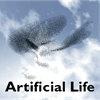Monte Carlo Physarum Machine: Characteristics of Pattern Formation in Continuous Stochastic Transport Networks
IF 1.6
4区 计算机科学
Q4 COMPUTER SCIENCE, ARTIFICIAL INTELLIGENCE
引用次数: 4
Abstract
We present Monte Carlo Physarum Machine (MCPM): a computational model suitable for reconstructing continuous transport networks from sparse 2D and 3D data. MCPM is a probabilistic generalization of Jones’s (2010) agent-based model for simulating the growth of Physarum polycephalum (slime mold). We compare MCPM to Jones’s work on theoretical grounds, and describe a task-specific variant designed for reconstructing the large-scale distribution of gas and dark matter in the Universe known as the cosmic web. To analyze the new model, we first explore MCPM’s self-patterning behavior, showing a wide range of continuous network-like morphologies—called polyphorms—that the model produces from geometrically intuitive parameters. Applying MCPM to both simulated and observational cosmological data sets, we then evaluate its ability to produce consistent 3D density maps of the cosmic web. Finally, we examine other possible tasks where MCPM could be useful, along with several examples of fitting to domain-specific data as proofs of concept.蒙特卡罗Physarum机器:连续随机传输网络中模式形成的特征。
我们提出了蒙特卡罗Physarum Machine(MCPM):一个适用于从稀疏的2D和3D数据重建连续传输网络的计算模型。MCPM是Jones(2010)基于代理的模型的概率推广,用于模拟小头藻(黏菌)的生长。我们在理论基础上将MCPM与Jones的工作进行了比较,并描述了一种特定任务的变体,该变体旨在重建宇宙中气体和暗物质的大规模分布,即宇宙网。为了分析新模型,我们首先探索了MCPM的自模式行为,显示了该模型根据几何直观参数产生的一系列连续的网络状形态,称为多形态。将MCPM应用于模拟和观测宇宙学数据集,然后我们评估其生成一致的宇宙网三维密度图的能力。最后,我们研究了MCPM可能有用的其他可能任务,以及几个拟合领域特定数据作为概念证明的例子。
本文章由计算机程序翻译,如有差异,请以英文原文为准。
求助全文
约1分钟内获得全文
求助全文
来源期刊

Artificial Life
工程技术-计算机:理论方法
CiteScore
4.70
自引率
7.70%
发文量
38
审稿时长
>12 weeks
期刊介绍:
Artificial Life, launched in the fall of 1993, has become the unifying forum for the exchange of scientific information on the study of artificial systems that exhibit the behavioral characteristics of natural living systems, through the synthesis or simulation using computational (software), robotic (hardware), and/or physicochemical (wetware) means. Each issue features cutting-edge research on artificial life that advances the state-of-the-art of our knowledge about various aspects of living systems such as:
Artificial chemistry and the origins of life
Self-assembly, growth, and development
Self-replication and self-repair
Systems and synthetic biology
Perception, cognition, and behavior
Embodiment and enactivism
Collective behaviors of swarms
Evolutionary and ecological dynamics
Open-endedness and creativity
Social organization and cultural evolution
Societal and technological implications
Philosophy and aesthetics
Applications to biology, medicine, business, education, or entertainment.
 求助内容:
求助内容: 应助结果提醒方式:
应助结果提醒方式:


